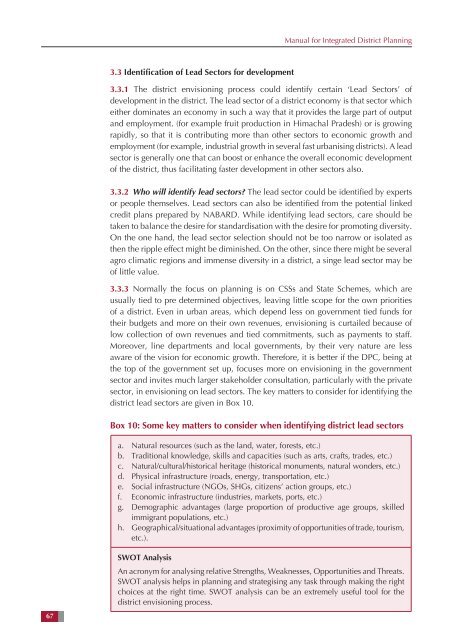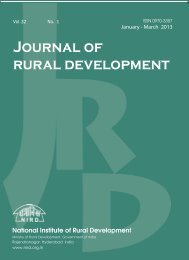Manual for Integrated District Planning - National Institute of Rural ...
Manual for Integrated District Planning - National Institute of Rural ...
Manual for Integrated District Planning - National Institute of Rural ...
Create successful ePaper yourself
Turn your PDF publications into a flip-book with our unique Google optimized e-Paper software.
<strong>Manual</strong> <strong>for</strong> <strong>Integrated</strong> <strong>District</strong> <strong>Planning</strong><br />
3.3 Identification <strong>of</strong> Lead Sectors <strong>for</strong> development<br />
3.3.1 The district envisioning process could identify certain ‘Lead Sectors’ <strong>of</strong><br />
development in the district. The lead sector <strong>of</strong> a district economy is that sector which<br />
either dominates an economy in such a way that it provides the large part <strong>of</strong> output<br />
and employment. (<strong>for</strong> example fruit production in Himachal Pradesh) or is growing<br />
rapidly, so that it is contributing more than other sectors to economic growth and<br />
employment (<strong>for</strong> example, industrial growth in several fast urbanising districts). A lead<br />
sector is generally one that can boost or enhance the overall economic development<br />
<strong>of</strong> the district, thus facilitating faster development in other sectors also.<br />
3.3.2 Who will identify lead sectors? The lead sector could be identified by experts<br />
or people themselves. Lead sectors can also be identified from the potential linked<br />
credit plans prepared by NABARD. While identifying lead sectors, care should be<br />
taken to balance the desire <strong>for</strong> standardisation with the desire <strong>for</strong> promoting diversity.<br />
On the one hand, the lead sector selection should not be too narrow or isolated as<br />
then the ripple effect might be diminished. On the other, since there might be several<br />
agro climatic regions and immense diversity in a district, a singe lead sector may be<br />
<strong>of</strong> little value.<br />
3.3.3 Normally the focus on planning is on CSSs and State Schemes, which are<br />
usually tied to pre determined objectives, leaving little scope <strong>for</strong> the own priorities<br />
<strong>of</strong> a district. Even in urban areas, which depend less on government tied funds <strong>for</strong><br />
their budgets and more on their own revenues, envisioning is curtailed because <strong>of</strong><br />
low collection <strong>of</strong> own revenues and tied commitments, such as payments to staff.<br />
Moreover, line departments and local governments, by their very nature are less<br />
aware <strong>of</strong> the vision <strong>for</strong> economic growth. There<strong>for</strong>e, it is better if the DPC, being at<br />
the top <strong>of</strong> the government set up, focuses more on envisioning in the government<br />
sector and invites much larger stakeholder consultation, particularly with the private<br />
sector, in envisioning on lead sectors. The key matters to consider <strong>for</strong> identifying the<br />
district lead sectors are given in Box 10.<br />
Box 10: Some key matters to consider when identifying district lead sectors<br />
a. Natural resources (such as the land, water, <strong>for</strong>ests, etc.)<br />
b. Traditional knowledge, skills and capacities (such as arts, crafts, trades, etc.)<br />
c. Natural/cultural/historical heritage (historical monuments, natural wonders, etc.)<br />
d. Physical infrastructure (roads, energy, transportation, etc.)<br />
e. Social infrastructure (NGOs, SHGs, citizens’ action groups, etc.)<br />
f. Economic infrastructure (industries, markets, ports, etc.)<br />
g. Demographic advantages (large proportion <strong>of</strong> productive age groups, skilled<br />
immigrant populations, etc.)<br />
h. Geographical/situational advantages (proximity <strong>of</strong> opportunities <strong>of</strong> trade, tourism,<br />
etc.).<br />
67<br />
SWOT Analysis<br />
An acronym <strong>for</strong> analysing relative Strengths, Weaknesses, Opportunities and Threats.<br />
SWOT analysis helps in planning and strategising any task through making the right<br />
choices at the right time. SWOT analysis can be an extremely useful tool <strong>for</strong> the<br />
district envisioning process.

















